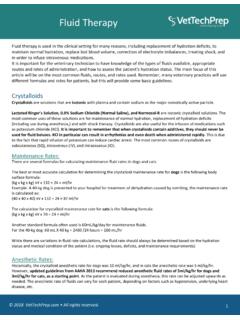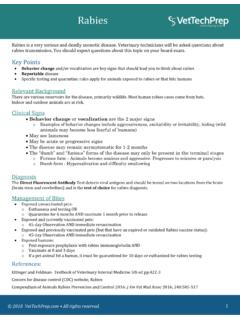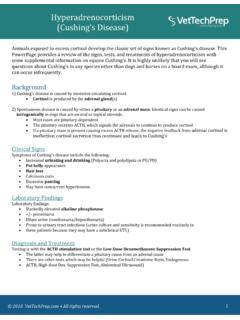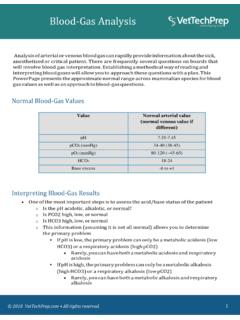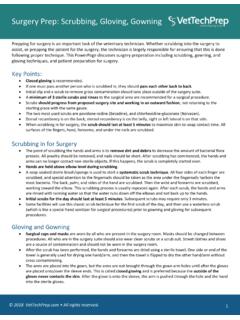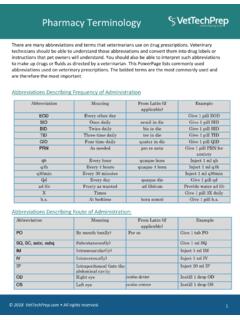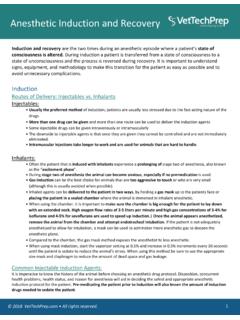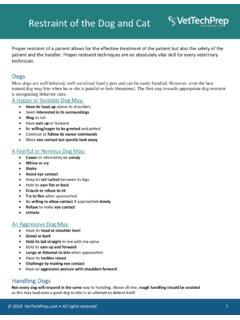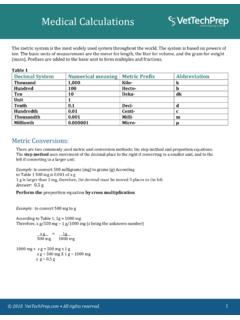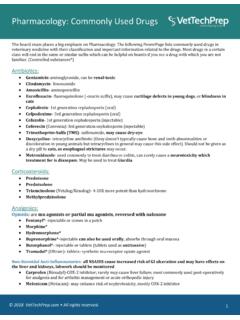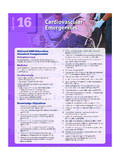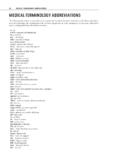Transcription of Cardiology - VetTechPrep
1 Cardiology The heart is obviously one of the most important vital organs. Veterinary technicians should have a good working knowledge of the anatomy and physiology of the heart. There will likely be several questions regarding Cardiology (including anatomy , physiology and cardiac medications) on the board exam. anatomy and Blood Flow Vessels of the heart: Vena Cava- brings de-oxygenated blood from the body to the heart and empties into the right atrium. Aorta- largest vessel in the body and carries oxygenated blood from the left ventricle to the body Pulmonary artery- transports the de-oxygenated blood from the right ventricle to the lungs. Pulmonary vein- transports oxygenated blood from the lungs to the left atrium. Coronary arteries- branch off of the aorta near the top of the heart and carry oxygen to the cardiac muscle tissue. Chambers of the heart: Left Atrium- receives oxygenated blood from the lungs via the pulmonary vein.
2 During contraction, blood passes from the left atrium through the mitral valve into the left ventricle. Left Ventricle- receives oxygenated blood from the left atrium during contraction. As the blood goes through the mitral valve and into the left ventricle, the aortic valve is closed so that the ventricle may fill. After the ventricles are full, they contract. During contraction, the mitral valve closes to prevent backflow of blood and the aortic valve opens to allow the blood to go into the aorta and out to the body. Right Atrium- receives de-oxygenated blood from the body via the vena cava. During contraction blood passes from the right atrium through the tricuspid valve and into the right ventricle. Right Ventricle- receives de-oxygenated blood from the right atrium during contraction. As the blood goes through the tricuspid valve and into the right ventricle, the pulmonary valve is closed so that the ventricle may fill.
3 During contraction, the tricuspid valve closes to prevent backflow and the pulmonary valve opens so that blood goes into the pulmonary artery and to the lungs. A Summary of Cardiac Circulation (commit to memory): Deoxygenated blood goes from body to heart via vena cava, empties into right atrium, through tricuspid valve into right ventricle, through pulmonic valve into pulmonary artery, to the lungs through the pulmonary circulation, gas exchange occurs in the lungs to oxygenate blood, to the pulmonary vein, into the left atrium through the mitral valve into left ventricle, through the aortic valve into the aorta, then to the body where gas exchange occurs in the capillaries. 2018 All rights reserved. 1 Valves and other structures of the heart: Mitral Valve- separates left atrium from left ventricle Tricuspid Valve- separates right atrium from right ventricle Pulmonary Valve- separates right ventricle from the pulmonary artery.
4 Aortic Valve- separates left ventricle from the aorta. Chordae tendinae- tendons which link the papillary muscles to the valves and aid in opening and closing of the valves. String-like in appearance. Papillary muscles- contract to open the valves. Connected to chordae tendinae. physiology The heart is composed of cardiac muscle (a striated muscle) and acts as a pump to circulate blood throughout the body. The Cardiac Cycle: Systole occurs when the ventricles are contracting. During systole, blood is ejected from the ventricles into the arteries leaving the heart. The left ventricle empties into the aorta and the right ventricle empties into the pulmonary artery. The pressure created during this contraction is called systolic pressure. Diastole occurs when the ventricles are relaxed. During this time the ventricles are filling with blood, preparing for the next contraction. Electrical Conduction in the Heart: Sinoatrial Node (SA Node) - the natural pacemaker of the heart.
5 It starts the electrical impulses in the heart, which then travel to the Atrioventricular node (AV node) (at the lower right atrium), spread through nerves in the ventricles and stimulate a wave of contractions. The AV node delays the impulse until the ventricles are completely filled. The impulses pass from the AV node through the right and left bundle branches (at the Bundle of His) which send impulses to cause cardiac contraction. Purkinje fibers are specialized cardiac muscle cells that conduct impulses deep within the myocardium assisting to transmit impulses from the AV node to the ventricles. Depolarization and Repolarization: Cells resting are polarized (no electrical activity is occurring). The cell membrane separates the concentration of the ions (Na, K, Ca) which is the resting potential. When an electrical impulse is generated (as discussed above), the ions cross the cell membrane to cause an action potential, or depolarization.
6 This causes the cardiac cells to contract. This occurs primarily via an influx of calcium into the cells. This calcium influx triggers actin and myosin fibers to contract. Repolarization is the ions returning to resting state. Terminology Preload- stretching of the cardiac cells prior to contraction, most related to right atrial pressure. Contractility- intrinsic ability of the heart to contract independent of preload and afterload. Afterload- tension against which the ventricles contract. Left ventricular afterload determined by the aortic pressure. Right ventricular afterload is determined by the pulmonary artery pressure. Anesthetic Machine Components 2018 All rights reserved. 2 Cardiology Stroke volume (SV)- the amount of blood pumped by the left ventricle per contraction. Heart Rate (HR)- the number of heart beats per minute. Cardiac output (CO) = SV X HR Central Venous Pressure (CVP)- pressure of blood in the thoracic vena cava, a good way to monitor hydration status in patients.
7 Asystole- a state of no cardiac electrical activity (flatline) Echocardiogram (ECG)- a recording of the electrical activity in the heart. Arrhythmia- abnormal heart rhythm, may be seen on an ECG A Few Cardiac Conditions to Know Dilated Cardiomyopathy (DCM)- weakened and enlarged heart; may be associated with taurine deficiency in some cases Hypertrophic Cardiomyopathy (HCM)- hypertrophy or thickening of the myocardium (heart muscle); sometimes associated with hyperthyroidism in cats Congestive Heart Failure (CHF)- heart can no longer pump blood efficiently and leads to pulmonary edema (fluid in the lungs) Second-degree AV block (common in horses)- arrhythmia causing delay at the AV node, often caused by high vagal tone in athletically fit horses, may resolve with exercise. May see a p wave with no QRS on an ECG. Ventricular fibrillation (V-fib)- uncoordinated contraction of the cardiac muscle in the ventricles.
8 It is during V-fib that a defibrillator may be used to try and induce back to a normal rhythm. Cardiac Drugs Furosemide (Lasix)- a loop diuretic used in congestive heart failure. (side note: diuretics increase urination). Spironolactone- an aldosterone antagonist used as a potassium sparing diuretic. Enalapril- an ace inhibitor/ vasodilator used often in conjunction with a diuretic for treating CHF. Pimobendan (Vetmedin)- inodilator used in treatment of CHF in dogs with CHF from valvular disease or from DCM. Atropine- anticholinergic, given to increase heart rate, often during anesthesia or during arrest. Nitroglycerine- potent venodilator, often used in acute CHF as a topical (must wear gloves). Sildenafil (Viagra)- used mostly in vet med for treating pulmonary hypertension. Lidocaine- used to treat ventricular tachycardia and VPC s (ventricular premature contractions) Digoxin- cardiac glycoside, blood levels should be monitored to prevent toxicity.
9 References Nelson, O. Lynne. Small Animal Cardiology . The Practical Veterinarian. 2003. Elsevier. Plumb, Donald C. Plumb s Veterinary Drug Handbook. 6th Edition. 2008. Blackwell Publishing. 2018 All rights reserved. 3 Cardiology
